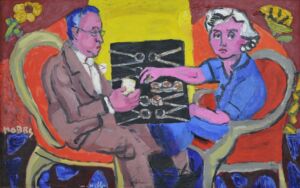
Backgammon Players, Oil on Canvas, 25″ x 39”
The Mary Gale Hobbs’ collection in Hennepin History Museum is bright and full of character. Hobbs’ bold color choices catches the eye and her playful portraiture imparts personality, not just of the subject, but herself.
Mary Gale Hobbs (1887 – 1973) was born in Canada. After getting a degree in Fine Arts from the University of Toronto, she moved to the Twin Cities. It was here that she taught art at Northrop Collegiate School in 1917. Hobbs painted many portraits, often paying her cleaners to sit for a painting at the end of their shifts. She was criticized for her “irresponsibly unrealistic” art. As John K. Sherman, art critic for the Star Tribune once wrote, “likely as not she’ll give one of her subjects a mop of scarlet hair or green eyebrows.” Hobbs agreed with this criticism and thrived in it. “I love bright colors, and I splash ‘em.”
The painting seen here, Backgammon Players, is dream-like. The players, Hobb’s and her husband, have purple skin and are seated in red cushioned chairs. The backgammon board sits between them, resting on their knees. The painting is more planar than recessive; this is most apparent when you look at the board, which appears to be standing on its side. The backgammon board itself is simplified and made more compact to suit the style of the work. The flowers that hang in the air add to the whimsical atmosphere. While her husband looks at her, Hobb’s is looking towards the viewer. She seems disinterested as she moves her stone across the board, though her gaze creates a connection to the viewer.
Whether Hobbs’ art is described as irresponsibly unrealistic or whimsical, it is certainly an example of an artist’s use of color to convey meaning, and portraiture to convey personality. Other works by Hobbs in Hennepin History Museum’s collection include many portraits of her family, as well as landscapes and assemblages. Hobb’s work demonstrates that art doesn’t always have to be grand or mysterious to be memorable, nor follow traditional convention to captivate the viewer.
Author Bio: Written by Summer Erickson, former Visitor Services Manager and Collections Assistant at Hennepin History Museum. Erickson graduated with a B.A. in Art History and Museum Studies from the University of St. Thomas in 2020. They cataloged HHM’s art collection in 2021. Erickson is currently working as a receptionist for MSS.
Bibliography
Burke, Evelyn. “Mother and Daughter Show Sculpture and Paintings.” Star Tribune. Sep. 29, 1948.
Hennepin History Museum. “Mary Gale Hobbs – a retrospective.” GovDelivery. Jun. 01. 2015. Accessed
October 20, 2021. https://content.govdelivery.com/accounts/MNHENNE/bulletins/1063c72
“Mary Gale Hobbs.” Star Tribune. Feb. 01, 1973.
https://startribune.newspapers.com/clip/83235893/star-tribune/
Sherman, John K. “Mary Gale Hobbs Exhibits Exuberant and Colorful Art.” The Minneapolis Star. Jun. 29, 1941. https://startribune.newspapers.com/clip/83235852/the-minneapolis-star/
 This blog was made possible in part by the people of Minnesota through a grant funded by an appropriation to the Minnesota Historical Society from the Minnesota Arts and Cultural Heritage Fund. Any views, findings, opinions, conclusions or recommendations expressed in this publication are those of the authors and do not necessarily represent those of the State of Minnesota, the Minnesota Historical Society, or the Minnesota Historic Resources Advisory Committee.
This blog was made possible in part by the people of Minnesota through a grant funded by an appropriation to the Minnesota Historical Society from the Minnesota Arts and Cultural Heritage Fund. Any views, findings, opinions, conclusions or recommendations expressed in this publication are those of the authors and do not necessarily represent those of the State of Minnesota, the Minnesota Historical Society, or the Minnesota Historic Resources Advisory Committee.
